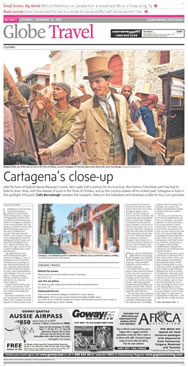Cartagena's close-up
Like
the hero of Gabriel Garcia Marquez's novel, who waits
half a century for his true love, this historic Colombian
port has had to bide its time. Now, with the release of
Love in the Time of Cholera, and as the country shakes
off its violent past, Cartagena is back in the spotlight.
Intrigued, Colin Barraclough wanders the ramparts, listens
to the balladeers and develops a taste for tiny corn pancakes
How
the film - finally - got made in Cartagena
COLIN
BARRACLOUGH
November 10, 2007
Hollywood's
take on Love in the Time of Cholera may anger literary
purists on its release next Friday. "We'll certainly take
some black eyes," admits British-born director Mike Newell
(Four Weddings and a Funeral ), "partly for doing it in
English, but mostly for having tried in the first place
- a lot of people believe you shouldn't touch holy work."
Marquez, near-deified by admirers of South American literature,
has long resisted turning his novels into cinema. It took
three years of wooing before Stone Village Pictures producer
Scott Steindorff, an American who made his money as a
real-estate developer in Las Vegas, finally wrested a
deal from Marquez for the film rights to his 1985 novel.
Initially planning to shoot the movie in Brazil, Steindorff
now says he's grateful that Colombian authorities persuaded
him to switch to Cartagena.
"Colombia's Vice-President, Francisco Santos, asked us
to take a look at Cartagena," Steindorff said. "Mike Newell
and I went down, and we loved it. It's one of the most
romantic cities in the world. It has this charm and beauty
- and it's the authentic location for the story."
 |
Newell, too, was reluctant to shoot in a city with
such obvious logistical difficulties. "When
Scott told me we were going to Colombia, I thought:
'drugs and guns,' " he said. "Curiously,
though, I never felt any danger. Of course, we always
had a team of security people with us [very common
for filming in South America.] It was my first time
in Latin America, yet I felt very safe."
Shooting in Cartagena, allowed the director to choose
locations that closely matched Marquez's novelistic
settings.
The plot, loosely based on the story of Marquez's
own parents, follows an incurable romantic, Florentino
Ariza played by Spain's Javier Bardem), who loses
the love of his life, Fermina Daza, (played by Italy's
Oscar-nominated Giovanna Mezzogiorno), but devotes
the following half-century preparing for the day
he might once again have her.
Cartagena has hosted a number of major film shoots
in the past, including the 1968 thriller Burn, starring
Marlon Brando, and the Academy Award-winning The
Mission. Grace Kelly even filmed Green Fire there
in the 1950s. As the first major film shot in the
city since the 1980s, however, Love in the Time
of Cholera will probably generate a significant
buzz. |
"People are intrigued with Colombia, and particularly
with Cartagena," Steindorff said. "This film is going
to be important for the city and for the whole country."
Location
HIGHLIGHTS
Teatro Heredia Carrera 4, 38-10, Plaza de la Merced; 57
(5) 664 9631. With its ornate gold-leaf interior and excellent
acoustics, this stunning theatre provided Newell with
a location for a poetry competition. Now the home of Cartagena's
ballet company, it has also hosted the Miss Colombia pageant
and Marquez's 80th birthday party.
Convento de San Pedro Claver Plaza de San Pedro Claver;
57 (5) 664 4991. Named for a 17th Jesuit monk canonized
for his ministry to Colombia's slave population, this
monastery, open as a museum, provided a key location:
Fermina Daza, the story's leading lady, elects to be married
there to punctilious doctor Juvenal Urbino (Benjamin Bratt).
Casa del Marques de Valdehoyos Calle de la Factoria. Built
to be the city's largest private residence by the slave-trading
Marquis of Valdehoyos, and now a government-owned centre
for cultural events, the building features in the movie
as the home of Lorenzo Daza, Fermina's father.
Escuela de Bellas Artes (Fine Arts School) Calle de las
Bovedas, Plaza San Diego. Cartagena's colonial-era Fine
Arts School building provided two locations: Its exterior
served as the college where Florentino Ariza picks up
America Vicuna, while scenes from Fermina Daza's school
were filmed in the interior. Music students formed the
choir singing in the film's funeral and Christmas Eve
mass scenes.
Fuerte de la Tenaza (Tenaza Fort) Las Bovedas. Forming
part of the Old City walls, this fort provided the location
for the boat dock where Fermina Daza and Florentino Ariza
depart on their honeymoon cruise.
|
|
|

